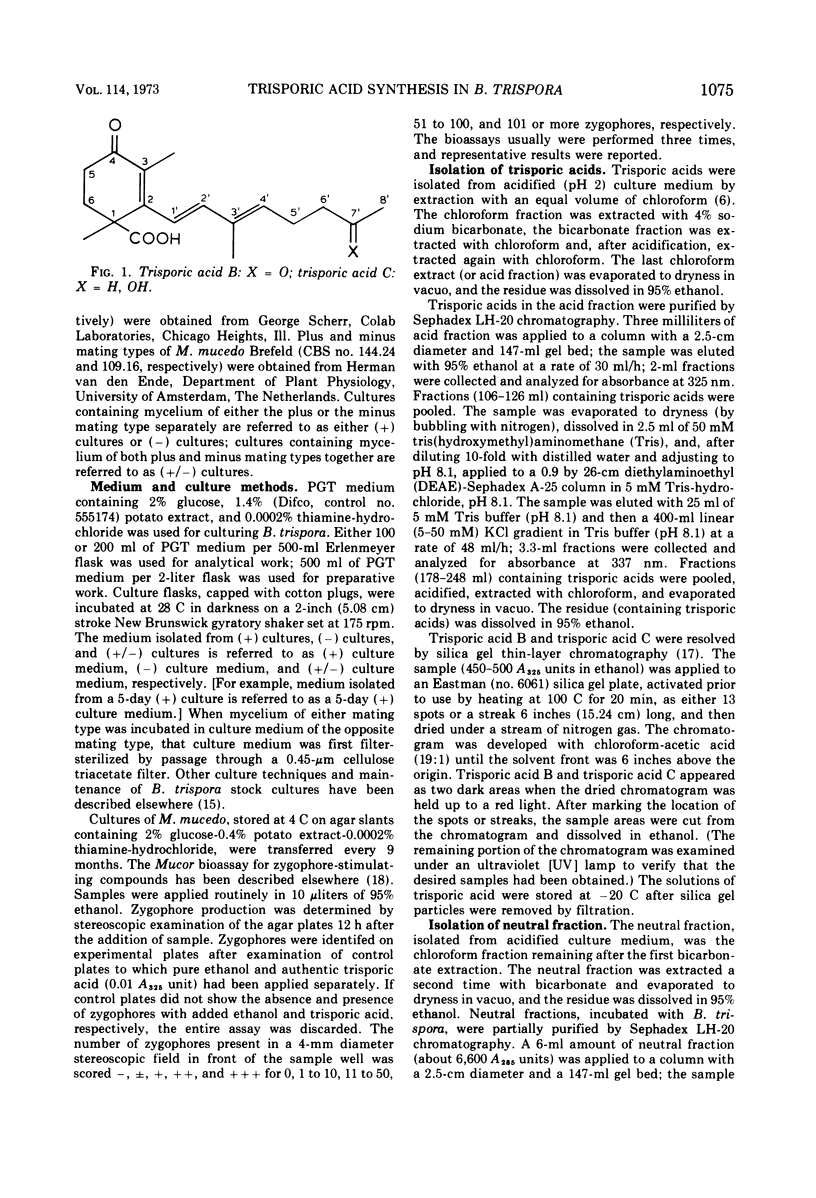Abstract
Separate plus and minus cultures of Blakeslea trispora synthesize small amounts of trisporic acids under specific conditions. These amounts are expressed as a percentage of the trisporic acids (50 mg/liter of medium) synthesized by mixed plus-minus cultures in 5 days. Plus cultures, without additives from minus cultures, synthesize 0.1% trisporic acids. Plus cultures synthesize 0.4% trisporic acids when stimulated by M-factor, a mating-type-specific component synthesized by minus cultures. Minus cultures, without additives from plus cultures, do not synthesize even 0.0001% trisporic acids. Minus cultures synthesize 1% trisporic acids when stimulated by P-factor, a mating-type-specific component synthesized by plus cultures. Minus cultures synthesize M-factor when stimulated by π, a component synthesized by plus cultures. We speculate that (i) minus cultures synthesize a component, μ, which stimulates P-factor synthesis in plus cultures, and (ii) both M-factor and P-factor are precursors of trisporic acids.
Full text
PDF








Selected References
These references are in PubMed. This may not be the complete list of references from this article.
- Austin D. J., Bu'Lock J. D., Drake D. The biosynthesis of trisporic acids from beta-carotene via retinal and trisporol. Experientia. 1970 Apr 15;26(4):348–349. doi: 10.1007/BF01896879. [DOI] [PubMed] [Google Scholar]
- Machlis L. The coming of age of sex hormones in plants. Mycologia. 1972 Mar-Apr;64(2):235–247. [PubMed] [Google Scholar]
- Reschke T. Die Gamone aus Blakeslea trispora. Zur Struktur der Sexualstoffe aus Mucoraceen. I. Mitt. Tetrahedron Lett. 1969 Aug;(39):3435–3439. doi: 10.1016/s0040-4039(00)99783-1. [DOI] [PubMed] [Google Scholar]
- Sutter R. P. Effect of light on beta-carotene accumulation in Blakeslea trispora. J Gen Microbiol. 1970 Dec;64(2):215–221. doi: 10.1099/00221287-64-2-215. [DOI] [PubMed] [Google Scholar]
- Sutter R. P., Rafelson M. E., Jr Separation of beta-factor synthesis from stimulated beta-carotene synthesis in mated cultures of Blakeslea trispora. J Bacteriol. 1968 Feb;95(2):426–432. doi: 10.1128/jb.95.2.426-432.1968. [DOI] [PMC free article] [PubMed] [Google Scholar]
- Sutter R. P. Trisporic acid synthesis in Blakeslea trispora. Science. 1970 Jun 26;168(3939):1590–1592. doi: 10.1126/science.168.3939.1590. [DOI] [PubMed] [Google Scholar]
- Van den Ende H., Wiechmann A. H., Reyngoud D. J., Hendriks T. Hormonal interactions in Mucor mucedo and Blakeslea trispora. J Bacteriol. 1970 Feb;101(2):423–428. doi: 10.1128/jb.101.2.423-428.1970. [DOI] [PMC free article] [PubMed] [Google Scholar]
- van den Ende H. Relationship between sexuality and carotene synthesis in Blakeslea trispora. J Bacteriol. 1968 Oct;96(4):1298–1303. doi: 10.1128/jb.96.4.1298-1303.1968. [DOI] [PMC free article] [PubMed] [Google Scholar]
- van den Ende H., Werkman B. A., van den Briel M. L. Trisporic acid synthesis in mated cultures of the fungus Blakeslea trispora. Arch Mikrobiol. 1972;86(2):175–184. doi: 10.1007/BF00413370. [DOI] [PubMed] [Google Scholar]


